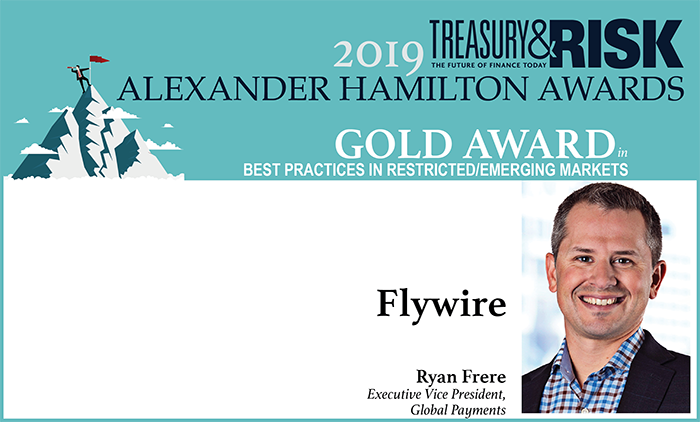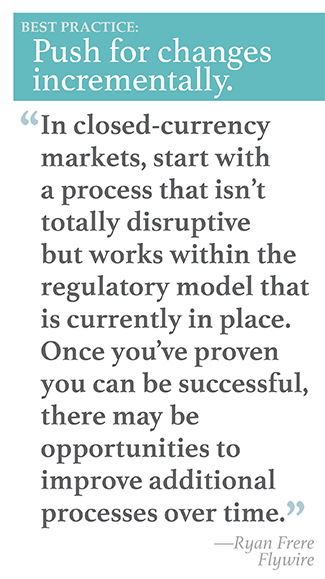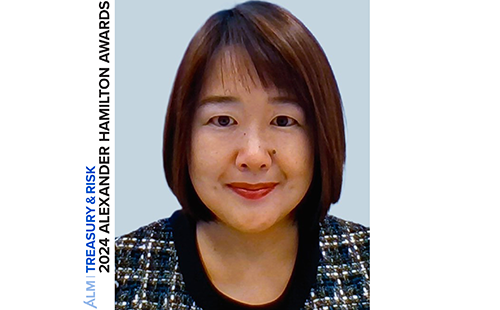
Boston-based vertical payments company Flywire was founded in 2011 to help international students pay for their education. "The initial goal was to assist universities like MIT, for example, in receiving tuition payments from markets all over the world," says Ryan Frere, the company's executive vice president of global payments. "Before Flywire existed, that was really challenging. What we've been able to do is streamline the cross-border payment process from the receiver's perspective."
Over the ensuing decade, Flywire's business has expanded beyond higher ed to support the healthcare and travel industries as well. Geographically, the company now serves clients and their customers across 220 countries and 150 currencies around the world, and has processed over $12 billion in both cross-border and domestic transactions. Still, its primary objective remains the same: "We work on behalf of our clients to make sure that their payers don't run into challenges with some of life's most important payments," Frere says.
One market from which cross-border payments tend to be challenging is India. That country has extensive documentation requirements for residents who want to send funds abroad—requirements that formerly presented a variety of hurdles in Flywire's attempts to facilitate aggregated international remittances. "India is second only to China in the number of outbound international students," Frere says, "but our processes for supporting payments out of India used to be manual and offline."
Educational payments are an approved cross-currency funds flow for the Reserve Bank of India (RBI), but the bank requires an approval process to ensure that the rupees are being converted for the right purposes. Flywire was providing an online funds-transfer service, but once Indian payers reached a certain point in the process, they would have to print an A2 ("Application for Drawal of Foreign Exchange") form and fill it out, providing detail about why they needed to exchange rupees. Then they would have to deliver the physical form to a Flywire partner organization within India, which would check the form for validity, file it away in case of audit by the RBI, and complete the currency conversion.
"The manual processes impacted the customer experience in three big ways," Frere says. "There was the manual process of filling out the form, which would sometimes take a payer days to complete because they had to physically bring the form into one of the branches of our partners. That was a hassle for payers, and it slowed down funds transfers."
Second, the manual process had a significant impact on the Flywire customer support group. "We received as many calls as you might anticipate," Frere reports. "Maybe a payer or their family had never before filled out an A2 form and needed assistance. Maybe they incorrectly answered some of the questions, which could be somewhat confusing."
Then, in addition to the up-front calls, the process involved manual verification and follow-up on the back end to ensure that everything looked right on the payer's A2 form. "Sometimes a payment would show up without the form filled out properly," Frere says. "Maybe the A2 form was missing, or maybe something seemed incorrect. The payment couldn't be released until the form was verified, and often that required a back and forth with the payer. So that was a pretty heavy lift as well."
 Over the past few years, India has been shifting toward allowing digital identification in meeting different types of regulatory requirements. Flywire saw this trend as an opportunity to potentially streamline funds flows. "Through our ongoing conversations with our partners in-market and our own research, we were aware that India was moving toward a new, digital approach to gathering the information that the A2 form collected," Frere says. "There was a strong push in-market to make these processes more digital."
Over the past few years, India has been shifting toward allowing digital identification in meeting different types of regulatory requirements. Flywire saw this trend as an opportunity to potentially streamline funds flows. "Through our ongoing conversations with our partners in-market and our own research, we were aware that India was moving toward a new, digital approach to gathering the information that the A2 form collected," Frere says. "There was a strong push in-market to make these processes more digital."
The first step Flywire took was to partner with Deutsche Bank. "Typically, when we are working with regulators on significant changes like this—and we have done this in multiple markets across the globe—we find it best to work closely with a financially regulated partner," Frere says. "We considered a number of prospective banking partners. We found that when we presented to Deutsche Bank what we wanted to do, and how we expected the regulatory changes to play out, they were eager not only to help us come up with a solution, but also to take our idea to RBI on our behalf.
"Our case is much stronger if it's coming from a financial institution that is registered in-market than if it's coming from us," Frere adds. "So we frequently pursue these types of joint conversations with central banks to get approval for our model. And that's how it worked in this case."
Flywire and Deutsche Bank explained the Flywire operating model to RBI regulators. After a year and a half of discussions, the RBI approved of Flywire opening a Special Non-Resident Rupee (SNRR) account at Deutsche Bank. "The bank was able to make sure it was set up in the right way because they had been part of the approval process," Frere adds.
Cross-border payers in India would still need to provide a significant amount of information about their payments, but the data could be collected electronically. Flywire worked with Deutsche Bank to ensure that its online form for requesting cross-border transactions out of India included all the data fields necessary to complete a Liberalised Remittance Scheme (LRS) declaration form.
Now that the system is functional, payers enter all the required information, along with their unique national permanent account number (PAN) ID, via Flywire's online form. Because Flywire is no longer relying on Indian partners to collect and validate information on paper forms, the company worked with an Indian technology provider to develop an automated digital process for conducting due diligence on payers. It uses the payer's PAN ID to confirm that the other data on the form matches government records. When the payer's identity is validated, all the necessary data flows automatically from Flywire into Deutsche Bank systems.
"Since we can do this in real time, it accelerates payment processing," Frere says. "We're also able to eliminate issues that might arise later on, saving time for both us and our payers. When we send all this information through to Deutsche Bank, they can automatically confirm that this is an approved payment, the right person, etc., in nearly real time."
See also:
In addition, Flywire worked with Deutsche Bank to develop a virtual account structure within its SNRR account. Each individual payment has its own account number. "We create the payment and send Deutsche Bank the necessary payment information, along with our reconciliation details," Frere says. "The Deutsche Bank system automatically creates a virtual account and sends that account number back to our system. That way, when the funds come back to us in the foreign currency, for us to send to our customer institution, it's a very easy reconciliation process because we know which payer account the funds are coming from."
Although the Flywire business model is somewhat unique, Frere thinks other organizations could learn from the company's approach to this project. "I think we do a good job of keeping a close connection to our clients and their payers, which helps us understand the pain points associated with these types of transactions," he says. "Also, keeping an eye on regulation and market research in different regions is critical. As the regulatory environment changes, you might find new ways in which you can improve your operations through digital methods."
To navigate regulatory changes, he advises other treasury professionals to make sure they have strong counsel in each market where they operate. "It's important to be comfortable with regulations yourself, but it's always good to get a second- or third-party view on it," Frere says.
Finally, he suggests approaching major projects incrementally. "If we'd walked into the RBI up front, by ourselves, without a bank and said, 'We're going to take all this digital and online, as an American offshore company,' I don't think the conversation would have gone much past that point in time," Frere says. "In closed-currency markets, where there are a lot of controls on funds flowing out, start with a process that isn't totally disruptive but works within the regulatory model that is currently in place. Then, once you've proven that you can be successful in that model, there may be opportunities to improve additional processes over time."
© Touchpoint Markets, All Rights Reserved. Request academic re-use from www.copyright.com. All other uses, submit a request to [email protected]. For more inforrmation visit Asset & Logo Licensing.



